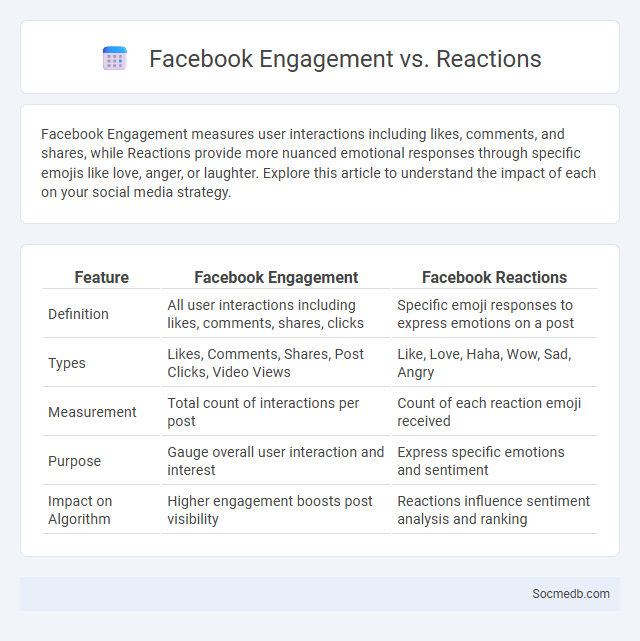
Photo illustration: Facebook Engagement vs Reactions
Facebook Engagement measures user interactions including likes, comments, and shares, while Reactions provide more nuanced emotional responses through specific emojis like love, anger, or laughter. Explore this article to understand the impact of each on your social media strategy.
Table of Comparison
| Feature | Facebook Engagement | Facebook Reactions |
|---|---|---|
| Definition | All user interactions including likes, comments, shares, clicks | Specific emoji responses to express emotions on a post |
| Types | Likes, Comments, Shares, Post Clicks, Video Views | Like, Love, Haha, Wow, Sad, Angry |
| Measurement | Total count of interactions per post | Count of each reaction emoji received |
| Purpose | Gauge overall user interaction and interest | Express specific emotions and sentiment |
| Impact on Algorithm | Higher engagement boosts post visibility | Reactions influence sentiment analysis and ranking |
Understanding Facebook Engagement: A Comprehensive Overview
Facebook engagement measures interactions such as likes, comments, shares, and clicks on posts, reflecting user interest and content relevance. Analyzing engagement metrics helps marketers optimize content strategies by identifying which posts generate the highest audience interaction. Understanding time spent, demographic data, and post type performance further enhances targeting and boosts overall page growth.
What Are Facebook Reactions?
Facebook Reactions are a set of emoji-based responses introduced by Facebook in 2016 to provide users with more nuanced ways to engage with posts beyond the traditional "Like" button. These six reactions include Like, Love, Haha, Wow, Sad, and Angry, each allowing users to express different emotions quickly and visually. Insights from these reactions help businesses and content creators analyze audience sentiment and tailor their strategies for better engagement on the platform.
Types of Engagement on Facebook Explained
Types of engagement on Facebook include likes, comments, shares, and reactions such as love, wow, and angry, which help gauge audience sentiment and interaction. Video views and saves are also critical metrics that measure content popularity and viewer retention. Messenger interactions and story replies further enhance direct communication and deepen user connection with brands or content creators.
The Differences Between Engagement and Reactions
Engagement on social media involves meaningful interactions such as comments, shares, and saves that indicate active participation with Your content, while reactions are quick responses like likes, hearts, or emojis reflecting immediate feelings. Engagement metrics provide deeper insights into audience behavior and content impact, whereas reactions offer a surface-level gauge of popularity. Understanding these differences helps optimize social media strategies for better connection and growth.
Why Facebook Distinguishes Engagements from Reactions
Facebook distinguishes engagements from reactions to provide more precise insights into user interaction patterns on its platform. Engagements encompass all user activities such as comments, shares, and clicks, offering a broader view of content performance. Your ability to analyze these detailed metrics helps optimize social media strategies and improve audience targeting effectively.
Key Metrics to Monitor: Engagement vs Reactions
Key metrics to monitor on social media include engagement rate, which measures interaction levels such as comments, shares, and saves, providing insight into content relevance and audience involvement. Reactions, encompassing likes and emotive responses, indicate immediate audience sentiment but may not fully reflect content impact or user intent. Tracking both engagement and reactions offers a balanced view of social media performance, helping optimize content strategies for deeper audience connection and brand growth.
How Facebook’s Algorithm Interprets Engagement and Reactions
Facebook's algorithm prioritizes content based on the type and frequency of user engagement, such as likes, comments, and shares, interpreting each interaction as a signal of relevance. Your reactions, including Love, Haha, Wow, Sad, and Angry, carry different weights, influencing which posts appear more prominently in your News Feed. This nuanced interpretation helps tailor your Facebook experience by promoting content that resonates most with your interests and social connections.
Analyzing Audience Behavior: Engagement Patterns vs Reactions
Analyzing audience behavior on social media reveals distinct engagement patterns and reactions that inform content strategy effectiveness. Tracking metrics such as likes, shares, comments, and time spent helps you understand which posts resonate emotionally or intellectually with your target demographic. These insights enable precise adjustments to content types, posting times, and messaging to maximize user interaction and brand loyalty.
Strategies to Boost Both Engagement and Reactions
Crafting content tailored to your audience's interests significantly boosts social media engagement and reactions. Utilizing interactive features such as polls, Q&A sessions, and live videos encourages active participation and fosters a sense of community. Consistently analyzing performance metrics allows you to refine your strategies and maximize the impact of your posts.
Measuring Success: Which Matters More—Engagement or Reactions?
Measuring social media success requires understanding the distinct roles of engagement and reactions in audience interaction. Engagement, including comments, shares, and clicks, indicates deeper user involvement and content resonance, while reactions such as likes or emojis reflect immediate emotional responses. Prioritizing engagement metrics offers more valuable insights for long-term brand growth and community building.
 socmedb.com
socmedb.com